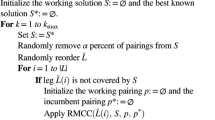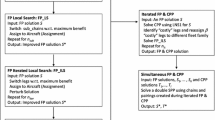Abstract
The monthly crew pairing problem (CPP) consists of determining a least-cost set of feasible crew pairings (sequences of flights starting and ending at a crew base) such that each flight is covered once and side constraints are satisfied. This problem has been widely studied but most works have tackled daily or weekly CPP instances with up to 3500 flights. Only a few papers have addressed monthly instances with up to 14,000 flights. In this paper, we propose an effective algorithm for solving very large-scale CPP instances. This algorithm combines, among others, column generation (CG) with dynamic constraint aggregation (DCA) that can efficiently exploit the CG master problem degeneracy. When embedded in a rolling-horizon (RH) procedure, DCA allows to consider wider time windows in RH and yields better solutions. Our computational results show, first, the potential gains that can be obtained by using wider time windows and, second, the very good performance of the proposed algorithm when compared with a standard CG/RH algorithm for solving an industrial monthly CPP instance with 46,588 flights.


Similar content being viewed by others
References
AhmadBeygi S, Cohn A, Weir M (2009) An integer programming approach to generating airline crew pairings. Comput Oper Res 36(4):1284–1298
Barnhart C, Shenoi R (1998a) An approximate model and solution approach for the long-haul crew pairing problem. Transp Sci 32(3):221–231
Barnhart C, Johnson EL, Nemhauser GL, Savelsbergh MWP, Vance PH (1998b) Branch-and-price: column generation for solving huge integer programs. Oper Res 46:316–329
Bouarab H, El Hallaoui I, Metrane A, Soumis F (2017) Dynamic constraint and variable aggregation in column generation. European J Oper Res 262:835–850
Chu HD, Gelman E, Johnson EL (1997) Solving large scale crew scheduling problems. European J Oper Res 97:260–268
Desaulniers G, Desrosiers J, Dumas Y, Marc S, Rioux B, Solomon MM, Soumis F. (1997) Crew pairing at Air France. European J Oper Res 97:245–259
Desaulniers G, Desrosiers J, Ioachim I, Solomon MM, Soumis F, Villeneuve D (1998) A unified framework for deterministic time constrained vehicle routing and crew scheduling problems. In: Crainic TG, Laporte G (eds) Fleet Management and Logistics, Norwell, pp 57–93
Desrosiers J, Dumas Y, Solomon MM, Soumis F (1995a) Time constrained routing and scheduling. In: Ball M et al (eds) Network Routing, Handbooks in Operations Research and Management Science, vol 8. Elsevier, Amsterdam, pp 35–139
Desaulniers G, Desrosiers J, Solomon MM (eds) (2005a) Column generation. Springer, New York
Desrosiers J, Lübbecke M (2005b) A primer in column generation. In: Desaulniers G, Desrosiers J, Solomon MM (eds) Column Generation, chap. 1. Springer, NY, pp 1–32
Deveci M, Demirel NÇ (2018) A survey of the literature on airline crew scheduling. Eng Appl Artif Intel 74:54–69
Dück V, Wesselmann F, Suhl L (2011) Implementing a branch and price and cut method for the airline crew pairing optimization problem. Public Transp 3(1):43–64
Elhallaoui I, Desaulniers G, Metrane A, Soumis F (2008) Bi-dynamic constraint aggregation and subproblem reduction. Comput Oper Res 35(5):1713–1724
Elhallaoui I, Metrane A, Desaulniers G, Soumis F (2011) An improved primal simplex algorithm for degenerate linear programs. Informs J Comput 23(4):569–577
Elhallaoui I, Metrane A, Soumis F, Desaulniers G (2010) Multiphase dynamic constraint aggregation for set partitioning type problems. Math Program 123(2):345–370
Elhallaoui I, Villeneuve D, Soumis F, Desaulniers G (2005) Dynamic aggregation of set partitioning constraints in column generation. Oper Res 53:632–645
Gopalakrishnan B, Johnson EL (2005) Airline crew scheduling: state-of-the-art. Ann Oper Res 140:305–337
Hoffman K L, Padberg M (1993) Solving airline crew scheduling problems by branch-and-cut. Manag Sci 39:657–682
Irnich S, Desaulniers G (2005) Shortest path problems with resource constraints. In: Desaulniers G, Desrosiers J, Solomon M (eds) Column generation. Springer, New York, pp 33–65
Jepsen M, Petersen B, Spoorendonk S, Pisinger D (2008) A non-robust branch-and-cut-and-price algorithm for the vehicle routing problem with time windows. Oper Res 43:297–325
Kasirzadeh A, Saddoune M, Soumis F (2017) Airline crew scheduling: models, algorithms, and data sets. EURO J Transp Logist 6(2):111–137
Klabjan D, Johnson E, Nemhauser G, Gelman E, Ramaswamy S (2001) Solving large airline crew scheduling problems: random pairing generation and strong branching. Comput Optim Appl 20:73–91
Lavoie S, Minoux M, Odier E (1988) A new approach for crew pairing problems by column generation with an application to air transportation. European J Oper Res 35(1):45–58
Lübbecke M E, Desrosiers J (2005) Selected topics in column generation. Oper Res 53(6):1007–1023
Mercier A, Cordeau JF, Soumis F (2005) A computational study of Benders decomposition for the integrated aircraft routing and crew scheduling problem. Comput Oper Res 32:1451–1476
Muter I, Ilker Birbil S, Bulbul K, Sahin G, Yenigun H, Tas D, Tuzun D (2013) Solving a robust airline crew pairing problem with column generation. Comput Oper Res 40(3):815–830
Parmentier A, Meunier F (2020) Aircraft routing and crew pairing: updated algorithms at Air France. Omega, forthcoming
Quesnel F, Desaulniers G, Soumis Fr (2017) A new heuristic branching scheme for the crew pairing problem with base constraints. Comput Oper Res 80:159–172
Quesnel F, Desaulniers G, Soumis F (2020a) A branch-and-price heuristic for the crew pairing problem with language constraints. European J Oper Res 283(3):1040–1054
Quesnel F, Desaulniers G, Soumis F (2020b) Improving air crew rostering by considering crew preferences in the crew pairing problem. Transp Sci 54(1):97–114
Saddoune M, Desaulniers G, Elhallaoui I, Soumis F (2012) Integrated airline crew pairing and crew assignment by dynamic constraint aggregation. Transp Sci 46(1):39–55
Saddoune M, Desaulniers G, Soumis F (2013) Aircrew pairings with possible repetitions of the same flight number. Comput Oper Res 40(3):805–814
Tahir A, Desaulniers G, Elhallaoui I (2019a) Integral column generation. EURO J Transp Logist 8(3):713–744
Tahir A, Desaulniers G, Elhallaoui I (2019b) Integral column generation for set partitioning problems with side constraints, Technical report, Les Cahiers du GERAD G-2019-85, HEC Montréal, pp 25
Vance PH, Barnhart C, Johnson EL, Nemhauser GL (1997) Airline crew scheduling: a new formulation and decomposition algorithm. Oper Res 45:188–200
Yaakoubi Y (2019) Combiner intelligence artificielle et programmation mathématique pour la planification des horaires des équipages en transport aérien. PhD dissertation Polytechnique, Montréal
Zaghrouti A, Soumis F, El Hallaoui I (2014) Integral simplex using decomposition for the set partitioning problem. Oper Res 62(2):435–449
Zeren B, Özkol I (2016) A Novel Column Generation Strategy for Large Scale Airline Crew Pairing Problems. Expert Syst Appl 55(C):133–144
Acknowledgments
We would like to thank the personnel of Ad Opt for providing the industrial datasets used in our computational experiments, discussing the proposed algorithms, and validating the computed solutions.
Funding
This study was financially supported by Kronos Inc. and the Natural Sciences and Engineering Research Council of Canada (grant RDC477127-14).
Author information
Authors and Affiliations
Corresponding author
Ethics declarations
Conflict of Interest
G. Desaulniers and F. Soumis have received a research grant from the company Kronos who owned Ad Opt when this research project was conducted. Ad Opt is now part of the company IBS Software.
Additional information
This article belongs to the Topical Collection on: Decomposition at 70
Appendices
Appendix 1. Pseudo-code of DCA algorithm
In this appendix, we give the pseudo-code of the DCA algorithm that includes the multi-phase and bi-dynamic strategies described in Section 3.2.1 and that can be used for solving a linear relaxation. It uses the notation introduced in Section 3.2 and the following one.
- L::
-
Pool of all generated columns;
- ARMP(Q)::
- (x, y)::
-
Current ARMP solution;
- N::
-
Set of negative reduced cost columns generated in a column generation;
- R::
-
Set of the pricing problem indices;
- PPr(k, h)::
-
Pricing problem r ∈ R subject to the restrictions imposed in phase k ∈ K of the multi-phase strategy and stage h ∈ H of the bi-dynamic strategy;
- \(\bar z^{C}(Q,N)\) :
-
(resp. \(\bar z^{I}(Q,N)\)): Least reduced cost of a column in N that is compatible (resp. incompatible) with Q (0 if no such column exists).

Appendix 2. Pseudo-code of IDCA algorithm
In this appendix, we give the pseudo-code of the IDCA algorithm that includes the multi-phase and bi-dynamic strategies described in Section 3.2.1 and that can be used for solving a linear relaxation. It uses the notation introduced in Section 3.2 and Appendix 1, as well as the following one.
- CP(Q, k)::
-
Complementary problem defined for partition Q and subject to the restrictions imposed in phase k ∈ K of the multi-phase strategy.

Rights and permissions
About this article
Cite this article
Desaulniers, G., Lessard, F., Saddoune, M. et al. Dynamic Constraint Aggregation for Solving Very Large-scale Airline Crew Pairing Problems. SN Oper. Res. Forum 1, 19 (2020). https://doi.org/10.1007/s43069-020-00016-1
Received:
Accepted:
Published:
DOI: https://doi.org/10.1007/s43069-020-00016-1




